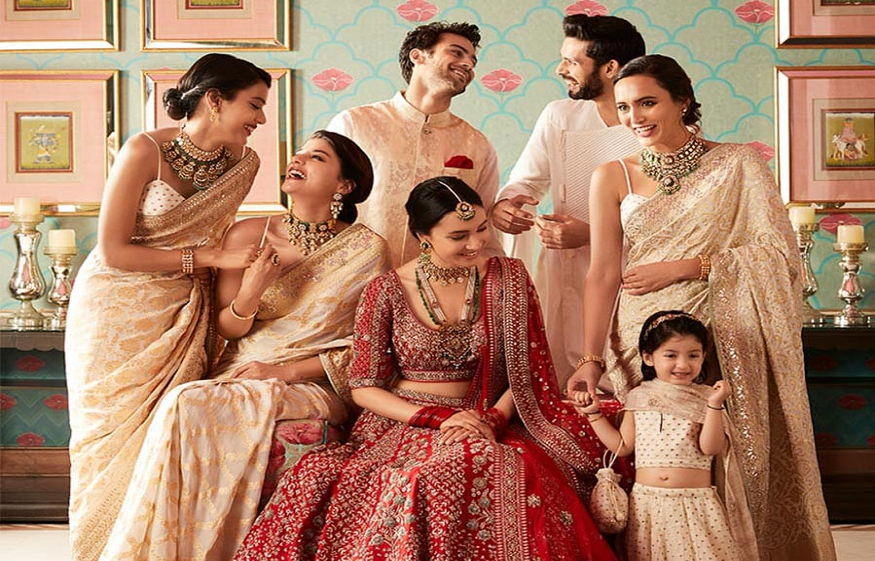Maharashtra
The traditional men’s attire of Maharashtra is a ‘dhoti’ or ‘dhotar’ which is a piece of cloth wrapped around the waist in various patterns. The natives also wear something called ‘pheta’. Women wear a nine-yard sari which is regionally called ‘nauvari saadi’ or known as ‘lugda’. However, with the rise of westernisation, traditional attires took a back seat and became rarer with trousers and shirts taking over the wardrobes. Formal attire is now worn only by Maharashtrians on special occasions and festivities such as Ganesh Chaturthi.
Kerala
The people of Kerala believe in minimalist dressing and prefer to keep their attire simple. Their simplicity is also reflected in their traditional attire. While the common attire for women in Kerala is believed to be the saree, many also prefer to wear a traditional dress that is worn around the waist, which is a two-piece dress called ‘neriyathu’. The neriyathu is worn diagonally by women. It starts from the left shoulder, where one end is tucked inside the waist garment.
The photo was taken on Shutterstock.
Nowadays, this outfit has been remodeled and given way to the ‘Set-sari’ or ‘Kerala sari’ which is a true full-length sari measuring about five and a half meters in length. It is now worn like a regular sari. However, no matter how much alteration it undergoes, the colour and border of the sari remain the same.
Bihar
The standard attire of the Bihari natives is ‘dhoti-kurta’ for men and saree or salwar kameez for women. Here too we see the increasing impacts of western culture on the society and the people of Bihar are swapping their traditional attire with western shirts and trousers and the women with jeans and tops or dresses. The traditional clothing styles of Bihar are known for their intricate handwoven textiles such as ‘tussar silk’ sarees, remaining the face of the unique and artistic Bihari dressing style.
West Bengal
The traditional dress of Bengali men is the ‘dhuti’, and the top or ‘kurta’ associated with the ‘dhuti’ is called ‘panjabi’.
In earlier times, especially during the colonial period, dhotis were white in colour with a very elaborate embroidery to form the border. However, nowadays, to add to the beauty of the attire, the dhoti is now available in various attractive colours to suit everyone’s preferences.
Mizoram
The most favorite dress of Mizo women is “Puran” and is preferred by many. The various bright colors surrounding the dress and the exceptional design help in creating a fabulous outfit. Puanchei or also known as “ponchu” is a very beautiful dress worn by Mizo girls during weddings and festivals like “Paut” or “Chapchar Kut”. The usual shades seen in the attire are black and white. However, sometimes you will also get to see a tint of color in between the light and white stripes.
Jammu and Kashmir
The traditional dress of the Kashmir Valley is ‘Pheran’ or ‘phiran’ for both men and women. This conventional dress extends up to the feet of the wearer and is extremely loose for everyone to wear. An updated version of the pheran which extends up to the knees is preferred these days. The dress consists of two robes and is worn one over the other.
Gujarat
Men in Gujarat generally prefer to wear ‘Chorno’, which can be described as a pair of cotton pants. It looks very much like a dhoti. Chorno is known as one of the most preferred garments in the state and hence is also easily available in the market. This style of clothing suits the hot and humid climate of the state quite well. Chorno is associated with something called ‘Kediyu’ worn as a top. The robe is a dress style similar to a gown and is worn mostly in the state of Gujarat.
Punjab
The traditional dress of Punjabi women is the salwar suit which replaces the old traditional dress called ‘Punjabi ghagra’. The Punjabi dress consists of a kurta or ‘kameez’ and a bottom called ‘salwar’. The Patiala style salwar is a very popular dress in India. The traditional dress of Punjabi men was earlier the kurta and tehmat which has been replaced by the kurta and pajama especially the ‘muktsari style’ which is well known in India. The dress is called muktsari style as it originates from the place Muktsar in Punjab.
Meghalaya
The weavers of Meghalaya, known as Garos, offer different types of clothing in the state. Garo women pair this skirt patterned bottom with a blouse and a lungi known as ‘ Dakmanda ‘ in the local language. Dakmanda is a kind of handwoven cotton fabric. Traditional clothing is also gaining popularity among Khasi women. Apart from this, Muga silk sarees from Assam are also quite famous among women from India and neighboring countries. Another style of clothing made of woolen fabric known as ‘Jainkup’ is mostly worn by older women. Along with Jainkup, women also adorn themselves with a headdress called ‘Kyrshah’.
Nagaland
Traditional clothing of Nagaland is synonymous with prosperity and success. The clothes are dyed in yellow and decorated with flowers. These clothing designs are created by the people belonging to the community itself, thus preserving the authenticity of their culture. Kilt is another type of dress that is worn other than the shawl. A kilt is signified as the working attire in Nagaland and is black in colour. The kilt is intricately decorated with cowrie shells . Before the cowrie shells are embedded on the kilt, they are rubbed against a stone to make them stick perfectly on the dress.

